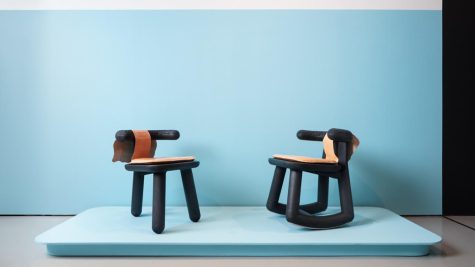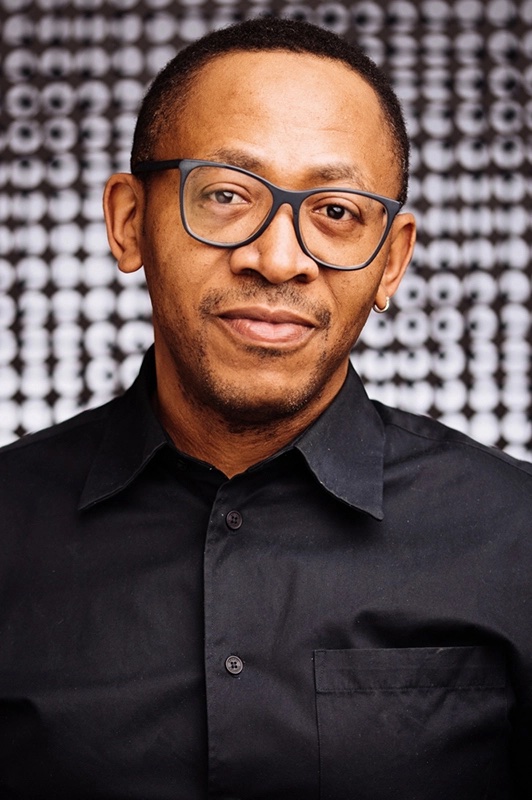On the Record with Norman Teague
Norman Teague’s Africana Rocking Chair was recently acquired by the Allen Memorial Art Museum and is currently on display in the Like a Good Armchair exhibition in the Ellen Johnson Gallery. Teague is the co-founder of blkHaUS Studios and founder of Norman Teague Design Studios, and will be one of the artists representing the United States in the 2023 Venice Biennale of Architecture. His work ties together design, architecture, and hands-on craftsmanship to create storytelling
objects.
This interview has been edited for length and clarity.
Your work seems to toggle between art and design; is it important for you to maintain this fluidity?
I’ve never really wanted to be pigeonholed to one or the other. And I know there’s a long line of history that says design and art are two different things — I’m not trying to get into that argument. Other people can have that debate, and in the meantime, I just want to go and make another piece of this or that. It’s really up to the artist to decide whether they want to, say, design metal, industrial furniture, or loose things that are more sculptural but can sit in a design gallery. I think design galleries have also been a super helpful movement in saying [that] these things can be sold for atelier prices, yet made at a limited edition level, where you don’t have to sell or make as many but the price tag can be high enough to support a studio practice.
When did you start telling stories through designing?
When I was going to the Art Institute of Chicago, it was really difficult, because there were a lot of killings of young Black men
at the hands of both young Black men and police. It seemed like a weekly thing. That was just a really emotional time for me and a lot of that was also part of the stories that I was trying to tell. I hung out with a couple of gangs, but I was never tough. But a big part of growing up was learning that I couldn’t go around looking too soft. They knew that I was a book-smart kind of dude and that I could draw. I did as much as I needed to do to survive, and I had a lot of really great friends that told me I should be doing some thing else.
Does your work aim to make deliberate space for and in your community?
I think when you have health opportunities within a neighborhood, and there’s a certain amount of space – physical space, as well as emotional, spiritual, and financial space – then you have the means to move something forward. There’s a certain amount of just sitting at the table. We all want to have a seat at the table now. But at that table, we also want to be able to make healthy decisions, have really healthy support. I think it has to be about finding longevity and continuation for that.
Do you see community building through art as an avenue for healing?
As I continue moving around the globe a little bit more, I have been seeing these amazing common spaces. Just down the street here in Oberlin, Ginko Gallery has a little woodshop with studios in the back. That just makes sense, because everybody needs a studio, so why not put one in the back of an art store? We’re all just trying to find ways to be closer to people and make making more accessible as we all work through our own bit of trauma. There’s something therapeutic about making a piece of pottery, or being in a painting class, or even constructing a log cabin together as a group. These things just make human sense, so why fight against it? We are constantly looking for a way to make communities better, and we just need to give communities better outlets. These are things that we just deserve to have, just like they used to have in park districts. You could go to any park and take a woodshop class or a stitching class or quilting, and it all got snatched away. People need these kinds of habits. Of course you want to go to school, you want to better your life, but sometimes you just want to take a class because you’re slightly interested in it and who knows, maybe you’ll be really good at it. But so many people never get to try. This is just work that we need to do in our cities.
What narrative does the Africana collection tell?
The Africana collection is really me thinking about my Western upbringing. It also brings in my African upbringing or historical narrative into that. It questions how to work with contemporary or modern styles, while also using traditional techniques of carving, stitching, or leather work. All of these combined when working with a piece of wood create something that can sit in a contemporary position, in a museum or in someone’s home. The narrative, for me, is the blending of the two in a very sexy way. A big part of it is also that it feels like there was little recordkeeping for people of color throughout history. I haven’t consciously been doing this, but I do ponder what it would be like if we were recorded, if alongside the Mies van der Rohe Farnsworth house, there could be an African roundhouse. I do think about what that history would look like had there not been such an unequal playing field. And part of my job is to improve upon the story.
How do you bring your identity into these stories?
It’s difficult because, when you’re a Black person, in some of these arenas I’m constantly thinking, “How do I keep it Black without without being too Black?” Too Black then you’re just like, “Ah, yeah.” And then it’s also like, “Well, why not be too Black? I can be too Black.” There’s a push and pull. There’s a constant question of which story can or should be told in each work. But for me, I think I could talk to you about each one of my pieces and reference something from Africa or something from my neighborhood, or something I felt was important to associate with that particular piece.












